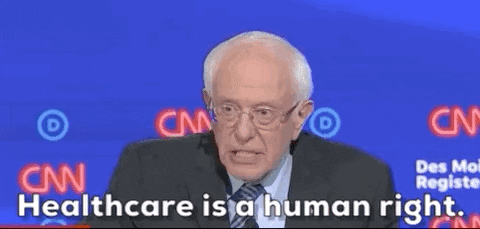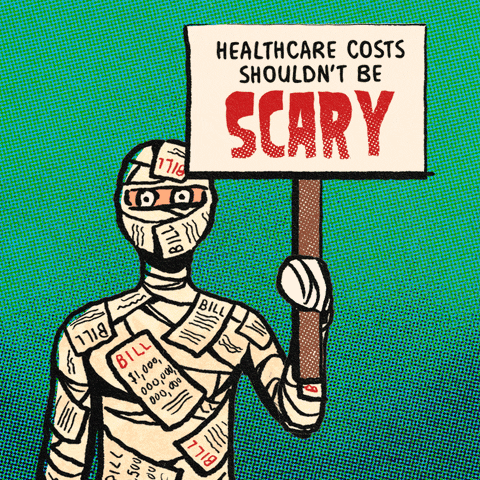Demystifying American Healthcare: Insights into Access, Costs, and Philosophical Frontiers

In navigating the complexities of America's healthcare system, I systematically sifted through the internet's most frequently asked questions, curating a focused list of 240 inquiries.
These questions have been thoughtfully organized into five sections, each addressing distinct aspects such as system intricacies, access challenges, and escalating costs. This streamlined approach aims to facilitate a nuanced exploration of key healthcare issues and foster discussions on viable solutions for achieving universal, affordable coverage.
America's complex healthcare system features exceptional innovations yet inequitable access and bankrupting bills. As costs spiral upwards, enabling affordable quality coverage for all remains debated across political divides centered on appropriate government involvement displacing dominant private insurers. This discussion will analyze key structures and controversies, focusing on system intricacies, access, and costs while contemplating viable pathways towards controlling expenses and achieving universal coverage.
1. Understanding Healthcare: Navigating the Complexity of the US System
The U.S. healthcare system is extraordinarily complex, with many private insurers, facilities, networks, and plans fragmenting access and costs. This poses challenges even for informed patients. Statistics show over 37 million Americans faced unaffordable medical bills last year, while spending reached $13,000 per person.
Unlike other advanced countries, around 9% of Americans lack insurance, as the U.S. has no universal publicly-funded healthcare. Costs are exceptionally high due to factors like administrative bloat and systemic profits. Achieving truly free healthcare faces legal and political barriers, so progress currently means slowly expanding public options.
How Does Healthcare Work in the US?
The U.S. system involves both private and public insurance coverage. Many get insurance through employers or family members, while seniors, the disabled, and low-income individuals qualify for Medicare and Medicaid. However, around 28 million remain uninsured.
Doctors, clinics and hospitals provide care, with prices varying widely. Most plans require members to pay deductibles, copays or coinsurance, resulting in high out-of-pocket costs even for the insured.
Where is Healthcare Free, and Why?
Most other high-income countries have government-funded universal healthcare supported by taxes. They believe healthcare is a basic human right for all citizens regardless of ability to pay. Universal systems aim to provide quality essential care efficiently and control costs.
Will Healthcare Ever Be Free in the US?
Free universal healthcare lacks political support currently in America. But pressure may grow as costs rapidly rise and Medicare's trust fund dwindles. Expanding public programs like Medicaid are more viable first steps to cover more uninsured people.
Where is Healthcare Most Expensive?
America has the world’s most expensive healthcare. Spending per person is almost $13,000, nearly twice as high as Switzerland. Key reasons include high prices and administrative overhead. Critics also blame billions in excessive insurance and hospital profits.
Is it Health Care or Healthcare?
Both “health care” and “healthcare” are accepted terms. “Health care” was favored initially as two words. But now healthcare as a single word is common usage. Writers have flexibility in styling today.
How the US System Works for the Uninsured
As uninsured patients pay full out-of-pocket costs, most wait until medical issues are critical and then use emergency rooms for care. Hospitals must stabilize them, but costs get passed on through rising premiums. The uninsured also avoid preventative care and managing chronic conditions, heightening vulnerability. Reforms aim to expand coverage.
Navigating Healthcare for Seniors
Medicare covers most seniors, but has cost-sharing they must pay. Choosing Medicare Advantage vs Original Medicare involves trade-offs. Prescription drugs pose major affordability issues, requiring add-on plans or assistance programs. Low-income seniors may qualify for Medicaid.
Exploring the Workings of the US Healthcare System
The $4 trillion U.S. healthcare sector is mostly private insurers and providers with autonomy. Public programs serve key groups, but gaps persist leaving millions without ready access. Insured individuals face out-of-pocket costs depending on their plan details. For uninsured Americans, quality preventative care remains largely out of reach.

2. Healthcare Workers' Rights: A Closer Look at Unionization
Healthcare workers play a crucial role in the well-being of communities. In this section, we delve into the rights of healthcare workers, exploring the topic of unionization and its impact on the workforce and patient care
Can Healthcare Workers Unionize?
Yes, most healthcare personnel can legally unionize, bargain collectively, and engage in related activities. But under 7% currently belong to a union, far below rates in other industries. Barriers include job diversity, legal restrictions, and anti-union pressures from health systems. Still major unions push expanding healthcare labor organizing.
Are Healthcare Workers Considered First Responders?
Most states don’t designate healthcare workers as first responders, unlike paramedics and EMTs providing emergency treatment and transport. But many argue they too serve critical frontline roles during public health crises, warranting more recognition and benefits.
Are Healthcare Workers Exempt from FFCRA?
Most healthcare staff retained COVID emergency leave protections. However, some federal exemptions allowed facilities to mandate personnel forego certain paid leave. Additional worker leave laws also emerged locally.
Can Healthcare Workers Refuse Vaccines?
Healthcare employers can require worker vaccinations to protect colleagues and patients. But laws around permittable exemptions for medical, religious or philosophical reasons differ by state. Suspending unvaccinated personnel has grown more common.
Rights When Considering Unionization
Union drives raise intense opposition but offer professionals pivotal leverage in advocating better compensation, stricter staffing ratios, robust workplace safety committees and other care enhancements. Counterarguments around inflexibility and divided priorities persist.
Potential Impacts on Nurse-Patient Ratios
Forming bargaining units provides nurses more leverage advocating for codified nurse-patient ratios citing duty risks, retention and outcomes. But administrators warn legislated ratios reduce flexibility addressing fluctuating needs across units. Both sides debate evidence on quality impacts.
Ensuring Workplace Safety
Union representation provides added protections addressing workspace safety concerns through joint committees with enforcement oversight. Nurses’ unions especially focus bargaining efforts around safety policies, protective equipment, injury tracking and related issues.
Certifying new bargaining units brings substantial challenges. But collective action remains essential for the healthcare workforce to secure balances against mounting pressures administrators’ consolidated powers enable.
3. Accessing Healthcare in the US: Demystifying the Options
Access to healthcare is a fundamental aspect of a well-functioning society. This section aims to demystify the options available for individuals seeking healthcare in the United States, including insurance coverage, public programs, and eligibility criteria
How Does Healthcare Work in the US?
America's healthcare system depends on private providers while government programs cover specific groups. About half receive employer-sponsored insurance. Medicare and Medicaid serve seniors, disabled and low-income, but over 27 million remain uninsured. Patients navigate variable costs across networks and drug plans. Even insured individuals may owe thousands in annual medical bills.
Is Health Care Free in the US?
Healthcare is not free for most people in the US. Unlike other countries with universal coverage, the American system relies on predominantly employment-linked private insurance. Only veterans, elderly, disabled, poor and some others get public health programs, which carry out-of-pocket costs aimed at bolstering affordability. Around 9% uninsured depend upon hospital emergency room access alone.
Do You Have to Pay for Health Insurance in the US?
There is currently no federal insurance mandate, unlike healthcare systems abroad. Going uninsured means fully self-paying medical costs. Tax penalties for lacking coverage existed from 2014-2018 under the ACA before reform eliminated fines.
What Happens if a Tourist Gets Sick in the USA?
Uninsured international visitors require travel insurance for affordable US care...
How Much do Americans Pay for Healthcare?
In 2020, US health spending topped $4 trillion, surpassing $12,000 per capita - nearly a fifth of total GDP, the highest globally by far...
Care Access for Undocumented Immigrants
Lacking comprehensive solutions around healthcare access as a human right, American system deficiencies leave populations from confused families to fearful immigrants without affordable care options. Progress fundamentally relies on political consensus that access constitutes an ethical imperative beyond privilege.
4. Decoding Healthcare Costs and Premiums: A Practical Guide
Understanding the factors influencing healthcare costs is vital for individuals navigating the system. In this segment, we break down the complexities of healthcare costs and premiums, offering practical tips for managing expenses effectively
Are Healthcare Premiums Tax-Deductible?
Self-employed filers and those with non-payroll deducted health plans can potentially deduct premium costs for themselves, spouses and dependents. However, deductions apply only above 7.5% of adjusted annual income. Additionally, rules differ on state returns regarding full or partial deductibility.
Are Healthcare Costs Rising?
Yes, health spending grows substantially every year, far surpassing general inflation. Total costs hit $3.8 trillion in 2019, over $11,500 per person - with projections showing 6%+ annual increases over the next decade likely. Key drivers include high prescription drug prices and advances in innovative hospital technologies and treatments. if current trajectories continue, per capita health spending could approach $20,000 by 2028.
How Much Is Private Healthcare?
Average family premiums now exceed $22,000 yearly for private employer plans, with the worker portion over $5,500, plus deductibles averaging $1,700. Supplementary policies add hundreds more out of pocket. Total household costs can quickly reach $20,000+ for major expenses.
If Healthcare Was Free, What Would Change?
Free healthcare through universal coverage would transform how medical care is delivered and financed. About 27 million uninsured Americans would instantly gain health access. Those previously paying premiums and cost-sharing may see major savings. However, sufficient taxes to fund a full single-payer transition would require reforms. Tradeoffs around covered services under a public plan would also emerge.
Tax Implications of Premiums
Leveraging tax advantages around premium costs involves navigating complex qualification factors related to plan types, income levels, and deductibility of basic vs. supplementary coverage. Maintaining detailed records remains vital to maximize legitimate healthcare deductions.
Managing Chronic Condition Costs
Budgeting for chronic conditions necessitates planning for accumulating deductibles, prescriptions and coinsurance despite insurance. Comprehensive policies with spending caps, drug coverage and broad networks can limit financial surprises alongside supplemental pre-tax and assistance programs when eligible.
Negotiating Medical Bills
With charges varying wildly between patients, self-advocacy merits effort. Estimate fair rates based on Medicare benchmarks and income constraints. Decide compromise limits beforehand when still facing impossibly high totals, then transparently seek discounts or installment arrangements from providers.

5. The Philosophy of Free Healthcare: Exploring the Pros and Cons
The idea of free healthcare sparks debates and discussions on a global scale. In this thought-provoking section, we explore the philosophical considerations surrounding free healthcare, examining its pros and cons in the context of various healthcare systems.
Should There Be Free Healthcare? Pros and Cons.
Free universal healthcare could expand access for all and reduce cost burdens, with advocates citing benefits like lower system-wide spending and untethering insurance from jobs. But enormous tax hikes would be necessary without sacrificing quality or access. Opponents argue innovation could decline if provider payments rely solely on capped government reimbursements rather than market incentives. $4 trillion sector disruption also risks revenues and profits.
Is Healthcare a Right or a Privilege?
Debates persist on whether healthcare constitutes a basic human right or an individual responsibility. Those seeing it as a right argue medical access shouldn’t hinge on socioeconomic status. Some also assert health is vital for equal opportunity in realms like jobs. But others emphasize individual accountability in acquiring coverage.
Why Is Healthcare So Expensive in America?
No single reason explains exceptionally high American healthcare costs. But contributors include profit-oriented insurers/providers, consolidation curbing competition, costly advances in treatments/technology, chronic disease prevalence, increased utilization of diagnostics, and more. Attempts at cost control consistently meet resistance given the sector’s economic centrality.
Free Healthcare vs Privatized System Tradeoffs
Arguments for single-payer’s advantages like broader access and lower system costs via centralized bargaining power conflict with risks of insufficient innovation if doctors rely chiefly on capped government reimbursements rather than market pressures. Long procedural wait times also often emerge. And achieving workable universal coverage funding in America faces legal and political monumentality given current system scale and entrenched interests.
Ethical Healthcare Funding Dilemmas
Appealing morally to ensuring care access regardless of affordability raises questions on ethical tax burdens imposed on citizens to finance costs of others’ coverage. With limited public resources, at what threshold does such taxation reach unreasonable infringement on rights and freedoms from collectivist versus individualist perspectives? There are no easy answers.
Impacts on Preventive Health
Eliminating financial barriers could significantly improve preventative medicine rates and public health through regular doctor visits, screenings, prescription adherence, substance abuse treatment and chronic disease monitoring. Investing upfront in population-wide prevention reduces eventual late-stage intervention needs.
Conclusion
In closing, while many advanced nations view healthcare as an essential public good meriting investment and coordination, the United States remains torn between commitments to markets versus collective responsibilities enabling care access for all.
Still, with insured families crushed by medical bills today, views may be tipping towards those advocating healthcare as a basic human right over corporate prerogatives. Although truly universal single-payer coverage still appears politically distant, even modest expansions of resources and protections for the vulnerable could progress the conversation on reform. As medical bankruptcies mount and life expectancy declines, the status quo may provoke action - or willingness to rediscover healthcare’s core purpose.
Key Takeaways
- Navigating Complexity: Healthcare professionals must adapt to the intricate landscape of the healthcare system, considering factors like technological advancements, patient diversity, and evolving practices.
- Continuous Learning: Lifelong learning is crucial for healthcare professionals to stay current with medical literature, breakthroughs, and emerging technologies, ensuring high-quality patient care.
- Patient-Centered Care: Embrace patient-centered care models, focusing on holistic approaches and cultural competency to provide inclusive and personalized healthcare services.
Thank you for reading this post! If you found it helpful or informative, please consider sharing a 7 day free trial with your friends, family, or colleagues who might benefit from it.
Your support helps me reach more people and spread awareness on important topics like this. Together, we can make a difference!




